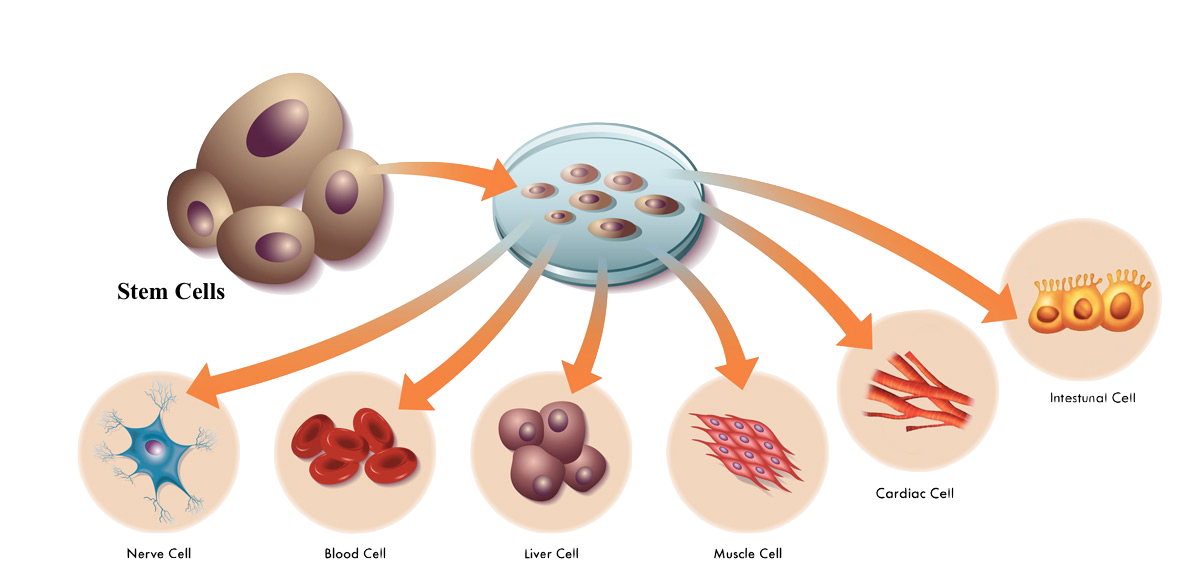The Future of medicine today
Regenerative Medicine Therapy
Your body has the natural ability to heal itself with stem cells and other growth factors.

Get A Risk-Free Consultation!
As you get older, the amount of stem cells you have in your body are greatly reduced and are not as effective. With the advancements in science over the past 20 years, stem cells have emerged as a key element of regenerative medicine therapies.
Regenerative Medicine
“The goal in Regenerative Medicine is to ‘regenerate not operate’, ‘repair not replace’ and ‘modify or slow down’ the progression of chronic disease by harnessing your body’s ability to heal itself.”
What is Regenerative Medicine?
Regenerative medicine is a form of tissue engineering and molecular biology which deals with the “process of replacing, engineering or regenerating human cells, tissues or organs to restore or establish normal function”. When injured or invaded by disease, our bodies have the innate response to heal and defend. Harnessing and enhancing the body’s own regenerative powers is a medical practice at the frontier of present-day advancements whose properties may seem miraculous to those who benefit from them. The miracle, however, is the result of scientific exploration that has begun to unlock and utilize the body’s extraordinary ability to heal and restore itself.
Everyone has heard of the advancement of stem cell therapy and its miraculous benefits. Stem cells help to regulate inflammation, which cause various autoimmune diseases and reduce pain in arthritic conditions, they promote the formation of new blood vessels necessary to bring nutrients to damaged areas to repair and regenerate new circulation in peripheral artery disease. Stem cell therapy outcome is very dependent on the age of the patient they are being harvested from, i.e. our stem cells are as old as we are and diminish with age…hence the aging process. Equally important in regenerative medicine, especially for patients over the age of fifty, are components such as collagens, cytokines, proteins, growth factors, the list goes on.
Each signal can start a chain of responses that determine what happens to the cell. Through medical technology we can now understand how individual cells respond to signals, interact with their environment, and organize themselves into a healing process. Scaffolds are created utilizing various Regenerative Medicine therapies allowing the tissue to “self- assemble.”
The “main function” of stem cells in adult tissue is to repair and regenerate the tissue in which they reside. Stem cell “plasticity” refers to the ability of adult stem cells to acquire mature phenotypes that are different from their tissue of origin.
Our bodies are comprised of cells allowing regenerative medicine therapies to work for us in a broad range of conditions including, but not limited to:
pain management
sports injuries
conditions of the spine
orthopaedics
aesthetics
hair restoration
male enhancement
wound healing
The list goes on and on.
Watch this video for more information.
• Control inflammation
• Modulate the immune system
• Stimulate regeneration
• Reduce scarring
MSCs secrete a curtain of bioactive molecules, or trophic factors, that help to dampen inflammation where appropriate. At a site of injury, the cells release trophic factors that tell the immune system to stop overreacting to the injury, which is the immune system’s natural response— to get to the site of injury and produce inflammatory molecules to help remove the damage.
Riordan, Neil H; Riordan, Neil H. Stem Cell Therapy: A Rising Tide: How Stem Cells Are Disrupting Medicine and Transforming Lives (Kindle Locations 892-899). Neil Riordan, PA, PhD. Kindle Edition.
Frequently Asked Questions…
WHAT IS REGENERATIVE MEDICINE?
Regenerative Medicine is a form of tissue engineering and molecular biology which deals with the “process of replacing, engineering or regenerating human cells, tissues or organs to restore or establish normal function”. When injured or invaded by disease, our bodies have the innate response to heal and defend. Harnessing and enhancing the body’s own regenerative powers is a medical practice at the frontier of present-day advancements whose properties may seem miraculous to those who benefit from them. The miracle, however, is the result of scientific exploration that has begun to unlock and utilize the body’s extraordinary ability to heal and restore itself.
HOW DOES REGENERATIVE MEDICINE WORK?
Cells are the building blocks of tissue, and tissues are the basic unit of function in the body. Generally, groups of cells make and secrete their own support structures, called extracellular matrix. This matrix, or scaffold, does more than just support the cells; it also acts as a relay station for various signaling molecules. Thus, cells receive messages from many sources that become available from the local environment. Each signal can start a chain of responses that determine what happens to the cell. Through medical technology we can now understand how individual cells respond to signals, interact with their environment and organize themselves into a healing process. Scaffolds are created utilizing various Regenerative Medicine therapies allowing for the tissue “self assemble”.
WHAT CAN REGENERATIVE MEDICINE BE USED FOR?
Regenerative medicine can be used for a multitude of conditions including, but not limited to pain management, sports injuries, spinal condition, podiatry, wound care, aesthetics, anti-aging, male enhancement, vaginal rejuvenation, hair restoration, the list goes on and on.
HOW WILL I KNOW WHAT THERAPY WORKS BEST FOR ME?
Based on your condition or injury your physician will customize a treatment plan for you and determine what therapy, or combination thereof, will work best for you.
WILL THE PROCEDURE BE PAINFUL?
In most cases the procedure involves a simple procedure and takes very little time. Guided imaging may be used depending on the area of the body being treated.
WHAT IS MY RECOVERY TIME?
Most patients experience little, if any, recovery time from the procedures? Your physician will provide you with the aftercare instructions prior to your returning home.
WILL MY INSURANCE COMPANY PAY FOR MY REGENERATIVE MEDICINE TREATMENTS?
Insurance coverages varies by state but in most cases no, your regenerative medicine treatment is not covered. We will provide you with an itemized statement so you may personally file a claim to your insurance provider.
WHAT IS THE COST OF REGENERATIVE MEDICINE TREATMENT?
The cost for regenerative medicine therapy is based on the procedure and type pf product needed. Our staff will sit down with you prior to your procedure and explain the cost as well as finance options if required.
Stem Cell References for your reading pleasure…
Applications of Amniotic Membrane and Fluid in Stem Cell Biology and Regenerative Medicine
Therapeutic Applications:
Cryopreserved Amniotic Suspension for the Treatment of Knee Osteoarthritis.
Cryopreservation:
Cryopreserved amniotic membrane as transplant allograft: viability and post-transplant outcome.
Will the Amniotic Membrane and its Stem Cells Preserve their Capacity After Cryopreservation?
Immunology:
Soluble Factors of Amnion-derived Cells in Treatment of Inflammatory and Fibrotic Pathologies
Human Amnion-derived Stem Cells Have Immunosuppressive Properties on NK Cells and Monocytes
Amniotic Membrane-derived Stem Cells: Immunomodulatory Properties and Potential Clinical Application
Miscellaneous:
Antibacterial Properties of Human Amnion and Chorion in Vitro
Potential Use of the Human Amniotic Membrane as a Scaffold in Human Articular Cartilage Repair
Chamberlain G, Fox J, Ashton B, Middleton J. Concise review: mesenchymal stem cells: their phenotype, differentiation capacity, immunological features, and potential for homing. Stem Cells. 2007;25( 11): 2739-2749.
Bachrach E, Perez AL, Choi YH, et al. Muscle engraftment of myogenic progenitor cells following intraarterial transplantation. Muscle Nerve. 2006;34( 1): 44-52.
Bailo M, Soncini M, Vertua E, et al. Engraftment potential of human amnion and chorion cells derived from term placenta. Transplantation. 2004;78( 10): 1439-1448.
Riordan, Neil H; Riordan, Neil H. Stem Cell Therapy: A Rising Tide: How Stem Cells Are Disrupting Medicine and Transforming Lives (Kindle Locations 4246-4252). Neil Riordan, PA, PhD. Kindle Edition.
Hernigou P, Flouzat Lachaniette CH, Delambre J, et al. Biologic augmentation of rotator cuff repair with mesenchymal stem cells during arthroscopy improves healing and prevents further tears: A case-controlled study. Int Orthop. 2014;38( 9): 1811– 1818. doi: 10.1007/ s00264-014-2391-1.
Emadedin M, Ghorbani Liastani M, Fazeli R, et al. Long-term follow-up of intra-articular injection of autologous mesenchymal stem cells in patients with knee, ankle, or hip osteoarthritis. Arch Iran Med. Jun 2015;18( 6): 336-344. doi: 012157/ AIM. 0010.
Bonab MM, Sahraian MA, Aghsaie A, et al. Autologous mesenchymal stem cell therapy in progressive multiple sclerosis: an open label study. Curr Stem Cell Res Ther. 2012;7( 6): 407-414.
Connick P, Kolappan M, Patani R, et al. The mesenchymal stem cells in multiple sclerosis (MSCIMS) trial protocol and baseline cohort characteristics: An open-label pre-test: Post-test study with blinded outcome assessments. Trials. 2011;12( 1).


